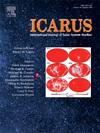Physical characteristics of Martian south polar ices determined by spatial- and intimate-mixture modeling
IF 3
2区 物理与天体物理
Q2 ASTRONOMY & ASTROPHYSICS
引用次数: 0
Abstract
Twenty-one spectral types for the perennial Martian south polar ices were determined from the Compact Reconnaissance Imaging Spectrometer for Mars (CRISM) data using k-means clustering. These data are higher spatial resolution than any previous measurement of these ices. We present both linear and radiative transfer models of those CRISM spectral types to determine the relative abundance and effective grain size of the three components that make up these surfaces: carbon dioxide ice, water ice and non-ice material. Most cluster means are well represented by a linear combination of five spectra, two types of CO2 ice, two types of water ice and a non-ice surface. To first order, each CRISM pixel is comprised of sub-pixel spatial mixtures of these five. We then use radiative transfer models to determine the best fit effective grain size and relative abundance of the five components. We use a relatively featureless area of the polar layered deposits for the non-ice component. Our models are consistent with prior modeling work and show very large grain sizes (mm to cm) in the residual CO2 with very small amounts of water (<0.04 wt%). Water dominated terrains have a wide range of grain sizes but are uniformly ∼80 % water ice. We identify a unique spectral type (C1) that does not have an equivalent in prior studies and may represent CO2 ice deposited when the atmosphere contained less water vapor following the dust storm of MY28.
Plain language summary
Ices at the south pole of Mars show absorption features associated with water ice, carbon dioxide ice and non-ice material. Prior work identified twenty-one spectral types that range in appearance from only carbon dioxide ice (CO2) to only water ice (H2O) with many mixtures in between these two. For the first time we model these mixed spectra using both linear least squares statistical approaches and more sophisticated models that account for the interaction of light with individual material grains where different grains are closely packed together. Most mixed spectra are well matched by the simple linear least squares fit of five different components. We then model those five components using the close-packing model. We find for the CO2 only ices the grains are very large and have minute amounts of water. For water ice dominated spectra they consistently are ∼80 % water 20 % non-ice material. One spectral type is unique and may reflect special conditions that occurred during one year when Mars experienced a large global dust storm.

火星南极冰的物理特征由空间和亲密混合模型确定
利用火星小型侦察成像光谱仪(CRISM)数据,采用k-均值聚类方法确定了火星南极冰的21种光谱类型。这些数据的空间分辨率比以往任何对这些冰的测量都要高。我们提出了这些CRISM光谱类型的线性和辐射传输模型,以确定构成这些表面的三种成分:二氧化碳冰、水冰和非冰物质的相对丰度和有效晶粒尺寸。大多数簇均值可以用五种光谱、两种CO2冰、两种水冰和非冰表面的线性组合来很好地表示。在一阶上,每个CRISM像素由这五个像素的亚像素空间混合组成。然后,我们使用辐射传输模型来确定最适合的有效粒度和五组分的相对丰度。我们使用相对无特征的极地层状沉积物区域作为非冰成分。我们的模型与先前的建模工作相一致,并且在含有极少量水(0.04 wt%)的残余CO2中显示出非常大的晶粒尺寸(毫米到厘米)。以水为主的地形有很宽的粒度范围,但均匀地约80%为水冰。我们确定了一个独特的光谱类型(C1),在以前的研究中没有等效的,可能代表在MY28沙尘暴后大气中含有较少的水蒸气时沉积的二氧化碳冰。火星南极的冰表现出与水冰、二氧化碳冰和非冰物质相关的吸收特征。先前的工作确定了21种光谱类型,其外观范围从只有二氧化碳冰(CO2)到只有水冰(H2O),以及两者之间的许多混合物。我们首次使用线性最小二乘统计方法和更复杂的模型来模拟这些混合光谱,这些模型解释了光与不同颗粒紧密堆积在一起的单个材料颗粒的相互作用。大多数混合光谱可以通过五种不同组分的简单线性最小二乘拟合得到很好的匹配。然后,我们使用紧密包装模型对这五个组件进行建模。我们发现,对于二氧化碳冰,颗粒非常大,只有少量的水。对于以水冰为主的光谱,它们始终是约80%的水和20%的非冰物质。有一种光谱类型是独特的,可能反映了火星经历一次大规模全球沙尘暴时发生的特殊情况。
本文章由计算机程序翻译,如有差异,请以英文原文为准。
求助全文
约1分钟内获得全文
求助全文
来源期刊

Icarus
地学天文-天文与天体物理
CiteScore
6.30
自引率
18.80%
发文量
356
审稿时长
2-4 weeks
期刊介绍:
Icarus is devoted to the publication of original contributions in the field of Solar System studies. Manuscripts reporting the results of new research - observational, experimental, or theoretical - concerning the astronomy, geology, meteorology, physics, chemistry, biology, and other scientific aspects of our Solar System or extrasolar systems are welcome. The journal generally does not publish papers devoted exclusively to the Sun, the Earth, celestial mechanics, meteoritics, or astrophysics. Icarus does not publish papers that provide "improved" versions of Bode''s law, or other numerical relations, without a sound physical basis. Icarus does not publish meeting announcements or general notices. Reviews, historical papers, and manuscripts describing spacecraft instrumentation may be considered, but only with prior approval of the editor. An entire issue of the journal is occasionally devoted to a single subject, usually arising from a conference on the same topic. The language of publication is English. American or British usage is accepted, but not a mixture of these.
 求助内容:
求助内容: 应助结果提醒方式:
应助结果提醒方式:


